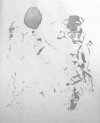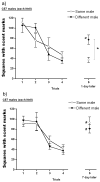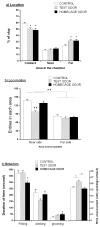Scent marking behavior as an odorant communication in mice
- PMID: 18565582
- PMCID: PMC2577770
- DOI: 10.1016/j.neubiorev.2008.05.012
Scent marking behavior as an odorant communication in mice
Abstract
In rodents, where chemical signals play a particularly important role in determining intraspecies interactions including social dominance and intersexual relationships, various studies have shown that behavior is sensitive to conspecific odor cues. Mice use urinary scent marks for communication with individual conspecifics in many social contexts. Urinary scent involves genetic information about individuals such as species, sex, and individual identity as well as metabolic information such as social dominance, and reproductive and health status, which are mediated by chemical proteins in scent marks including the major histocompatibility complex and the major urinary proteins. The odor of the predator which can be considered to be a threatening signal for the prey also modulate mouse behavior in which scent marking is suppressed in response to the cat odor exposure in mice. These odorant chemicals are detected and recognized through two olfactory bulbs, the role of which in detection of chemosignals with biological relevant appears to be differential, but partly overlapped. Mice deposit scent marks toward conspecifics to maintain their social relationships, and inhibit scent marking in a context where natural predator, cat odor is contained. This suppression of scent marking is long-lasting (for at least 7 days) and context-dependent, while the odorant signaling to conspecifics tends to appear frequently (over 24h but less than 7 days intervals) depending on the familiarity of each signal-recipient. It has been discussed that scent marking is a communicative behavior associated with territoriality toward conspecifics, indicating that the social signaling within species are sensitive to predator odor cues in terms of vulnerability to predation risk.
Figures




References
-
- Adamec R, Head D, Blundell J, Burton P, Berton O. Lasting anxiogenic effects of feline predator stress in mice: sex differences in vulnerability to stress and predicting severity of anxiogenic response from the stress experience. Physiol Behav. 2006;88:12–29. - PubMed
-
- Anderson PK, Hill JL. Mus musculus: Experimental induction of territory formation. Science. 1965;148:1753–1755. - PubMed
-
- Apfelbach R, Blanchard CD, Blanchard RJ, Hayes RA, McGregor IS. The effects of predator odors in mammalian prey species: a review of field and laboratory studies. Neurosci Biobehav Rev. 2005;29:1123–1144. - PubMed
Publication types
MeSH terms
Substances
Grants and funding
LinkOut - more resources
Full Text Sources
Miscellaneous

